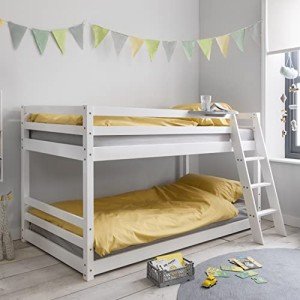10 Steps To Begin The Business You Want To Start Midsleeper Business
The Midsleeper: A Practical Solution for Kids' Bedrooms
When it comes to optimizing space in a child's bedroom, the midsleeper bed stands apart as an innovative and functional solution. Integrating the raised structure of a loft bed with the accessibility of a standard bed, midsleepers provide a distinct balance of play, storage, and sleeping options. This article will explore the functions, advantages, and considerations of midsleeper beds, providing moms and dads a detailed guide to comprehending this practical furniture piece.
What is a Midsleeper Bed?
Midsleeper beds rise beds that generally have a sleeping area raised off the ground, but not as high as a traditional loft bed. This permits a space beneath that can be used for different functions— whether it's for storage, a backyard, or a research study spot. Midsleepers typically deal with children and are designed with safety and functionality in mind.
Key Features of Midsleeper Beds
Height: Midsleepers are generally between 1.2 to 1.5 meters high, making them accessible for children while ensuring they are safe.
Under-bed Space: The location listed below the bed is frequently used for additional furniture or activities, consisting of desks, closets, or play locations.
Safety Features: Most midsleepers come equipped with guardrails and ladders that comply with security requirements, providing comfort for moms and dads.
Design and Customization: Available in numerous styles, colors, and designs, midsleepers can be tailored to fit any decoration, making them a versatile option in children's furnishings.
Storage Solutions: Many midsleepers include built-in storage choices, such as drawers or racks, to assist keep the bedroom organized.
Benefits of Choosing a Midsleeper Bed
Midsleepers provide numerous advantages that make them a popular option for children's bedrooms:
Space Efficiency
With the space-saving design of midsleepers, families can make use of the under-bed area for multiple functions. This can help keep the flooring without clutter and create a more orderly environment.
Support of Play and Creativity
The under-bed space encourages kids to utilize their imagination. They can develop a play zone, incorporating camping tents, slides, or perhaps a tiny castle, which promotes interactive play while guaranteeing the room remains neat.
Adaptability and Longevity
Midsleepers cater to children as they grow, permitting for a shift from a play area to a study zone. The included adaptability means that these beds can adjust to the changing needs of a kid from toddlerhood to early adolescence.
Aesthetic Appeal
With many styles available, midsleepers can improve the general visual of a room. Moms and dads can choose styles that match existing furniture or create a whimsical environment that sparks a kid's creativity.
Factors to consider When Choosing a Midsleeper
Despite their many advantages, there are vital elements for parents to think about when selecting a midsleeper:
Room Size: Measure the offered area in the bedroom to guarantee it can accommodate a midsleeper without making the room feel cramped.
Age and Size of the Child: Ensure that the height of the bed appropriates for your child's age and size. Many midsleepers are safe for children aged six and older due to their height.
Security Standards: Check for security accreditations, ensuring the midsleeper complies with local regulations regarding children's furnishings.
Access and Mobility: Consider how quickly your kid can access the bed. Ladders or stairs need to be strong and safely connected to promote ease of use while also not being a tripping danger.
Style and Storage Needs: Assess your kid's preferences and the required storage area. Choose a midsleeper that complements the interior decoration of the room while fulfilling storage needs.
Table: Key Differences Between Various Bed Types
Function
Midsleeper
Loft Bed
Bunk Bed
Standard Bed
Height
Medium (1.2 – 1.5 m)
High (above 1.5 m)
Two beds stacked together
Low (normally ground level)
Under-bed Space
Yes
Yes
Yes (only one bed area)
No
Recommended Age
6+
8+
6+
2+
Safety Features
Guardrails, durable ladder
Guardrails, sturdy ladder
Guardrails
None
Area Efficiency
High
Very High
Moderate
Low
Frequently Asked Questions About Midsleeper Beds
1. What age is suitable for a midsleeper bed?
Midsleeper beds are typically recommended for kids aged six and older, guaranteeing they can safely browse the height and structure of the bed.
2. Do midsleeper beds need unique mattresses?
Midsleeper beds usually utilize standard single or twin mattresses, but it is necessary to inspect the producer's standards for specific recommendations relating to thickness or size.
3. How can I ensure my child is safe in a midsleeper?
To promote security, ensure that the bed is established properly, acquaint your child with using the ladder, and examine that guardrails are set up and safe and secure.
4. Can I personalize a midsleeper bed?
Yes! Mid Sleeper Cabin Bed come in different styles and can be tailored with devices such as camping tents, slides, and storage services to match your child's choices.
5. Are midsleepers simple to assemble?
The majority of midsleeper beds come with straightforward assembly guidelines, permitting parents to set them up without expert assistance. Nevertheless, it's advisable to have an additional pair of hands to help.
Midsleeper beds present an exceptional option for households looking for to enhance space in kids's rooms while supplying a safe and fun sleeping arrangement. With their flexible styles, safety functions, and myriad choices for personalization, they cater to the needs of growing kids and adjust as those requirements alter. By thoroughly considering aspects such as room size, security requirements, and aesthetic choices, moms and dads can pick the best midsleeper to increase company and motivate creativity in their kid's bedroom.
